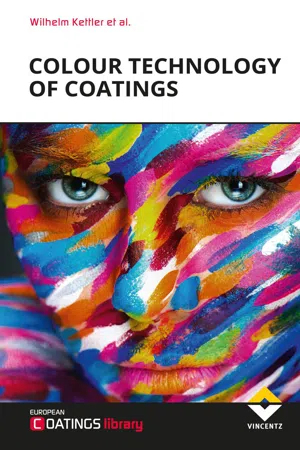
Colour Technology of Coatings
- 300 pages
- English
- PDF
- Available on iOS & Android
Colour Technology of Coatings
About This Book
Like many other textbooks, this one has its origins in the classroom and is the culmination of more than 10 years' experience of teaching courses on colorimetry to engineers and technicians from various branches of industry. The VDMI, the VdL and the FPL asked various experts at pigments, paints, and instrument makers in 2000 to design various training modules for colourists working on industrial, plastics, paint, and print applications of colour. The objective was to provide a technically correct and up-to-date introduction to those many aspects of colour and colour applications in industry. The target group was engineers deeply involved in colour applications in various industrial sectors. The first set of training modules was offered in 2001. Until retiring in 2014, Dr. Tasso Bäurle successfully steered the ship for almost 14 years, taking charge of the training modules. He continually refined and modified the underlying concept to meet the demands of the participants and participating industries. The latest version comprises just two modules covering elementary concepts of colorimetry and in-depth insights in colorimetry. Although the main focus is on paint applications, all the methods presented can be readily adapted to colour applications in other industries. The main purpose of this book is to provide a comprehensive survey of relevant industrial colour applications and numerous concepts of physical and physiological pigment optics in order that a written record may be preserved of the specialist knowledge of all the lecturers involved in the coloristic training course. The colour problems discussed in this book include optics and chemistry of solid-colour and effect pigments, colourant formulation, optical microscopy of effect colour shades for pigment identification, methods of elementary and advanced colorimetry, measurement and visual assessment of solid and effect colour shades, colour tolerances and acceptability, and colour-order systems. Compared to the first German edition, this English edition contains a further chapter devoted to the newly emerging area of visual texture assessment of effect colour shades. Although technology for measuring visible texture is already available on the market, no mathematically rigorous definition of texture parameters and their dimensionality has been formulated so far that would be accepted throughout the colour community. However, a combination of multidimensional texture and colour information is the appropriate paradigm to adopt for proper physical characterisation of the visual appearance of effect colour shades. The contents of this book are a mix of objective detachment on one hand and a detailed first-hand knowledge and practical relevance on the other. The mathematics throughout the book have been kept to a minimum, even though the technical treatment of colour problems is being driven more and more by mathematical models. Many references at the ends of chapters cite original papers. The reader is encouraged to consult these as further sources of information and to supplement the physical and physiological basics presented in this book with more general mathematics and rigor, as necessary. As this English edition of the training course for colourists was being prepared, one of the authors, Dr. Gerhard Rösler, unexpectedly passed away in December 2012. I believe that Gerhard would be pleased with the expanded English edition of our joint project. Wilhelm H. Kettler Wülfrath, Germany, January 2016
Frequently asked questions
Information
Table of contents
- Preface
- Contents
- I. Fundamentals of colour perception
- II. Colour measurement, colour measurement systems and visual colour assessment
- 1. Principles behind measuring coloured surfaces
- 2. Measuring geometries
- 3. Measuring geometries for special effect pigments
- 4. Sample preparation
- 5. Recommended colourimetric conditions
- 6. Influence of the surface
- 7. Special case: optical brighteners and fluorescence
- 8. Sources of error in colour measurements
- 9. Profiling of measuring instruments and colour management
- 10. Non-contact colour measurement
- III. Visual colour assessment
- IV. Colour-order systems
- V. Instrumental colour difference assessment
- VI. Definition and application of colour tolerances
- VII. Pigment optics – physical processes
- 1. Colour-generating processes
- 2. Reflection, refraction, diffraction, interference
- 3. Mie theory
- 4. Kubelka-Munk function for opaque layers
- 5. Saunderson correction: how surfaces influence the outcome of reflectance measurements
- 6. Kubelka-Munk equation for transparent layers
- 7. Multi-flux theory
- VIII. Practical applications
- IX. Measuring the texture of effect finishes
- X. Characterisation of pigments
- 1. Inorganic pigments – characterisation
- 2. Organic pigments – characterisation
- 3. Characterisation of aluminium pigments
- 4. Characterisation of pearlescent pigments and special effect pigments
- XI. Recipe prediction
- 1. Recipe prediction for solid colours
- 2. Calibration of colourants
- 3. Computer-aided correction of colour recipes
- 4. Practical colour-recipe prediction of gonioapparent colours
- 5. The profitability of colour recipe calculation
- 6. Guidelines for formulating and matching object colours
- 7. Recipe dosability
- 8. Structure of colour mixing systems
- 9. Optimisation of colour mixing systems
- 10. Colour gamuts and the limits of colour matching
- XII. Microscopic analysis of effect pigments
- Autors
- Index